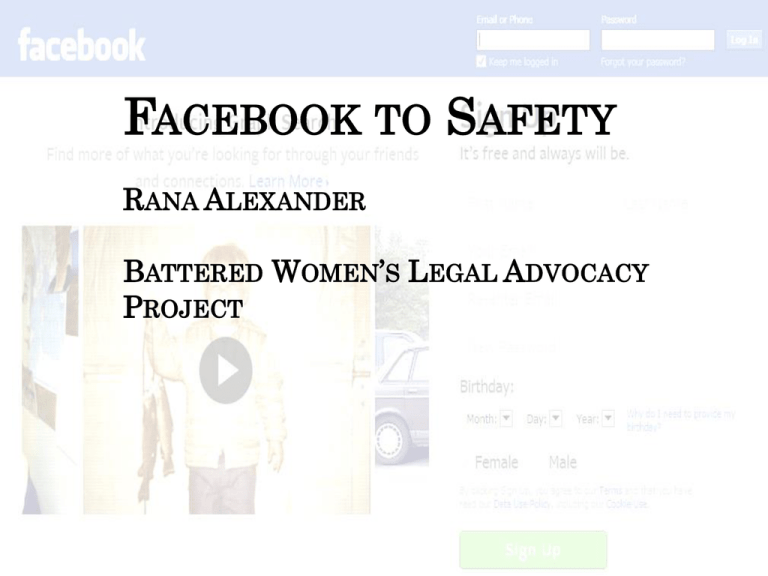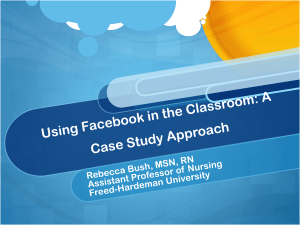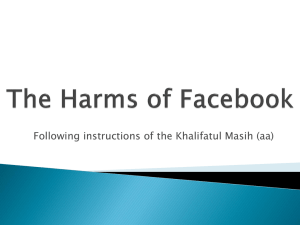Facebook-to-Safetyfi.. - Evergreen Youth & Family Services
advertisement

FACEBOOK TO SAFETY RANA ALEXANDER BATTERED WOMEN’S LEGAL ADVOCACY PROJECT A QUICK OPENING NOTE… Will not cover everything Security settings are constantly changing This information could become out of date very quickly Will get you thinking about Facebook Risks and benefits for youth and victims Importance of safety planning around technology A FEW FACTS ABOUT FACEBOOK • Facebook has over 1.6 BILLION monthly active users • More than 70% of those who have Internet access have Facebook accounts • More than 50% of users log into Facebook on any given day • The average Facebook user has 130 friends. • More then 25% of Facebook users are under 10 • 59% of teens view social networks as unsafe • 24% of Americans aren’t confident in their ability to use privacy settings • 25% of Facebook users have their account set to public FACEBOOK IS VERY USEFUL • Connecting and chatting with friends and relatives • Making new friends • Sharing pictures, videos, etc. • Getting news and information • Finding help and resources • It’s FUN A FEW FACTS ABOUT TEEN DATING VIOLENCE 1 in 4 dating teens is abused or harassed online or through texts by their partners Victims of digital abuse and harassment are: 2 times as likely to be physically abused 2.5 times as likely to be psychologically abused 5 times as likely to be sexually coerced 8.7% of teens in relationships reported their partner used his/her social networking account without permission 5.1% of teens in relationships reported their partner wrote nasty things about him/her on his/her profile page FACEBOOK CAN ALSO POSE A SAFETY RISK • Track activities, friends, relationships, etc. • Find out current location • Use to harass and/or threaten • Security settings are constantly changing TRUST YOUR CLIENT’S INSTINCTS If the person you are working with suspects her abuser knows too much, it’s possible that her abuser has access to her Facebook account. IMPORTANT SAFETY CONCERNS When information is posted anywhere on the Internet, whether or not it is "locked" to friends-only or certain users are blocked, it is not 100% private. IMPORTANT SAFETY CONCERNS Includes MySpace, Twitter, Tumblr, Google+ or any other social networking site. Some sites/applications request (seem to require) you link your account to your Facebook account. Some websites and many online newspapers, require the use your Facebook account to comment. A FEW QUESTIONS TO ASK WHEN SAFETY PLANNING • Do you use Facebook? • Is your Facebook account friends-only, or is it publicly accessible by anyone? • If your account is friends-only, is the abuser one of your friends? What about friends or family members of his? • Is your Facebook password something your abuser couldn't possibly guess? • Does your email end up in a shared email client? CHOOSING A SAFER PASSWORD Virtually impossible for others to guess • Passwords should not be: • • • • • • Her name Nickname or initials Her address or phone number Names of children or pets Birth dates Anything else that would be easy for someone else to guess. • The best passwords are random number/letter combinations. For example: jl56rmqm34. • Or use a memorable phrase with spaces, numbers and punctuation. Ex: “St0p spy1ng On m3!” CHOOSING A SAFER PASSWORD If she changes her password, Facebook will send her an email confirming the password change. May be a safety concern if email is being monitoring (although the new password will not be in that email). MAKING A FACEBOOK ACCOUNT SAFER Users can (somewhat) choose what they want to share Status updates and pictures friends-only Birthday Public and contact information MAKING A FACEBOOK ACCOUNT SAFER • Choose your default privacy: friends vs. custom • Personal information • How you connect • How tags work • Creating posting filters MAKING A FACEBOOK ACCOUNT SAFER • Apps, games and web sites: public search • Limit the audience for past posts • Blocked people and apps • Selecting what to share on the profile • Checking in to locations • Be careful about what you “like” OPTIONS FOR LIMITING AN ABUSER’S ACCESS • Un/De-friend • Block • Restricted list • Use other lists • Safety First! CHECKING WHAT OTHERS CAN SEE ON A FACEBOOK ACCOUNT View your Facebook account as someone else Allows you to see if any security features (such as blocking) worked OTHER PEOPLE’S FACEBOOK ACCOUNTS AND TAGGING • If you post to someone else’s account you don’t have much control over your own privacy. • Tagging on posts and pictures. • Setting up account to notify when tagged. ABUSER LEAVES HARASSING/THREATENING MESSAGES • Report the message to Facebook • Get your friends to report the post to Facebook • Report the message to the police • Seek a protective order • Don’t forget to ask for relief that relates to the Facebook postings ABUSER LEAVES HARASSING/THREATENING MESSAGES • Take screenshots of any harassing messages/posts. These may be able to be used later as evidence. • How to take Windows or Mac screenshots: (a)Windows: Press Ctrl (control) + PrtScn (print screen) then paste into Paint, Word, or any photo/image editing software. (b)Mac: Press Command+Shift+3. This will save a .png image file on the computer's desktop. DO YOU HAVE FURTHER QUESTIONS ABOUT TECHNOLOGY AND SURVIVORS? Rana Alexander at the Battered Women’s Legal Advocacy Project: (612) 343-9844 or e-mail at rana@bwlap.org. Or call the National Network on Domestic Violence’s Safety Net Team at (202) 543-5566, ext 22.








